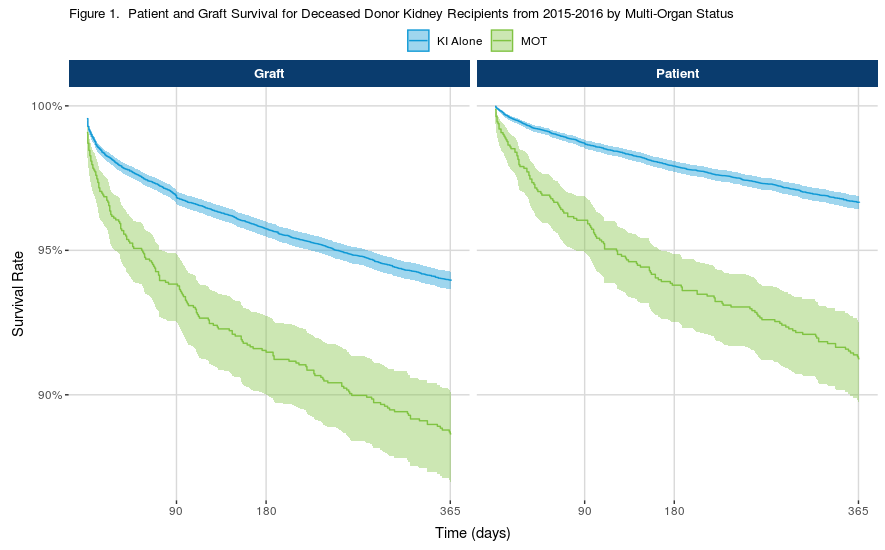Multi-Organ Transplant Results in Lower Patient and Graft Survival Than Kidney Alone Transplant
1United Network for Organ Sharing, Richmond, VA, 2Thomas Jefferson University, Washington, DC, 3Tufts University, Medford, MA, 4Northwestern University, Chicago, IL
Meeting: 2019 American Transplant Congress
Abstract number: 421
Keywords: Allocation, Kidney transplantation, Outcome, Survival
Session Information
Session Name: Concurrent Session: Kidney Deceased Donor Allocation III
Session Type: Concurrent Session
Date: Tuesday, June 4, 2019
Session Time: 2:30pm-4:00pm
 Presentation Time: 3:18pm-3:30pm
Presentation Time: 3:18pm-3:30pm
Location: Ballroom B
*Purpose: Kidneys are the most common organ involved in multi-organ transplants (MOT). MOT candidates often receive priority access to kidneys over single organ transplant (SOT) candidates seeking a kidney alone. This paper assesses the association between current allocation policies and MOT and SOT outcomes.
*Methods: Using OPTN data, the OPTN/UNOS Ethics Committee identified deceased donor adult kidney recipients from 2015-2017, with 1 year outcomes constrained to 2015-2016. MOT recipients were defined as those who received a kidney and another organ from the same donor (excluding pancreas). Mann-Whitney U test was used to analyze time on waiting list, eGFR at transplant, and kidney donor profile index (KDPI). Waiting list mortality was calculated as death rate per 100 patient years. The log-rank test was used to examine differences in 1-year survival outcomes between MOT and kidney SOT.
*Results: Of the 38,254 total deceased donor kidney recipients, 6.6% (2,533) were MOT. There was significant difference in time on the waiting list between MOT [median (IQR): 45 (11-183) days] and SOT [median (IQR): 712 (211-1436) days] (p<0.001). There was a significant difference in eGFR between MOT [median (IQR): 19.8 (11.7-32) mL/min/1.73 m2] and SOT [median (IQR): 6.5 (4.8-9) mL/min/1.73 m2] (p<0.001). KDPI also differed significantly between MOT [median (IQR): 35% (14-53%)] and SOT [median (IQR): 47% (25-68%)] (p<0.001). Waiting list mortality differed significantly in death rate (95% CI) between MOT with 36.4 (34.6, 38.3) deaths per 100 patient years and SOT with 8.8 (8.65-8.87) deaths per 100 patient years. One year patient survival rates differed significantly between MOT [91.2% (89.7-92.5%)] and SOT [96.7% (96.4-96.9%)] (p<0.001) (Figure 1). One year graft survival rates also differed significantly between MOT [88.6% (87.0-90.1%)] and SOT [94.0% (93.6-94.3%)] (p<0.001).
*Conclusions: MOT recipients spend significantly less time on the waiting list and receive lower KDPI kidneys despite higher kidney function at time of transplant compared to SOT recipients. Conversely, MOT recipients experience significantly higher waiting list mortality and significantly lower post-transplant survival rates. Further research should assess the outcomes of the multi-organ transplant allocation process to ensure the maximum utility of deceased donor kidneys.
To cite this abstract in AMA style:
Custer CA, Entwistle J, Ladin K, Cartwright L, Gordon EJ. Multi-Organ Transplant Results in Lower Patient and Graft Survival Than Kidney Alone Transplant [abstract]. Am J Transplant. 2019; 19 (suppl 3). https://atcmeetingabstracts.com/abstract/multi-organ-transplant-results-in-lower-patient-and-graft-survival-than-kidney-alone-transplant/. Accessed December 15, 2025.« Back to 2019 American Transplant Congress

